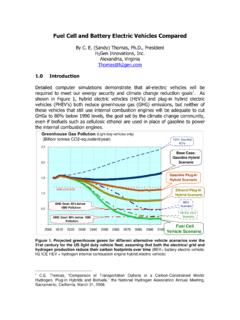Transcription of INFINERGY
1 INFINERGY RIDE THE $16 TRILLION REVOLUTION1 ONE of my favorite outdoor actives is kayaking on the lake near my house. I ve been drifting out there on weekends since I moved to Florida from New York. It s my happy place and gives me an opportunity to get exercise, fresh air and solitude. It s the perfect place for social distancing except for the random fishing boat or jet skier that buzzes by every so often. I ve recently noticed more and more houses along the lake sporting dark mirrored solar panels on the rooftops. It s interesting that Florida is known as the Sunshine State, yet only 1% of homes have solar. Florida and many other states have been slow to adopt renewable energy because of its high cost and inefficiencies. But this is about to all, it always takes time for life-changing innovations to catch on. We can look back at history for just such an example.
2 On December 31, 1879, a crowd of revelers gathered in the small town of Menlo Park, New Jersey. With the new year just hours away, they witnessed history when Thomas Edison revealed the incandescent lightbulb for the first the incandescent lamp was invented 40 years prior, the lightbulb only needed an electric current and could burn for hours. The crowd stood in amazement as the streetlight lit up the small village. Edison knew this was just the , he turned to reporters and uttered the now infamous statement: We will make electricity so cheap that only the rich will burn candles. Although the lightbulb ignited an electricity rollout across the nation, it wasn t an immediate revolution it took several decades to see the full impact. In fact, it wasn t until a half-century later that Edison s proclamation of accessible electricity came to fruition. By 1930, most American households in larger towns and cities had access to affordable electricity.
3 By then, a wave of new electric appliances had already hit the market the dishwasher in 1886, the washing machine and vacuum in 1908, and the refrigerator in 1913. These electric-powered inventions had profound impacts on society. Productivity increased as people started working at night. For the first time, people had free time from chores thanks to these new arrived but there was an environmental cost. Back then, 51% of these new devices energy came from coal-burning power plants. Traditional biofuels, such as vegetable oil, accounted for , while crude oil and natural gas made up the remainder. Although we ve moved beyond dishwashers and washing machines to Roomba vacuums and Ring doorbell cameras, electricity generation still comes from these same sources. In 2020, 61% of our power came from the same old fossil fuels. That s an even bigger percentage of old economy fuels than we used in 1930.
4 Ride the $16 Trillion INFINERGY RevolutionBy Ian King, Editor of Strategic Fortunes2Of course, the alternative to burning fossil fuels is renewable energy, which is derived from solar, wind, geothermal and hydroelectric sources. It currently accounts for only 38% of total electricity generation. But the pace of technology adoption is accelerating. Mega trends like e-commerce and working from home are rapidly changing the way we live and the way we do business. The future is all about doing more with less. Less trips to the grocery store, less visits to the office and even less spending on energy. But in order for that to happen, the renewable energy market will need to expand rapidly. Renewables will be the ultimate way of doing more with less. Our homes, business, and vehicles will be powered with abundant renewables, such as wind and solar. In fact, the International Energy Agency has laid out a roadmap that would take renewable energy s global market share to 90% by 2050.
5 They are calling the plan Net Zero. Many people think this estimate is unrealistic. But as I ll explain in a moment, we always underestimate the impact of new technology. For instance, the smartphone didn t even exist 16 years ago. However, this 150-gram pocket computer revolutionized the way we communicate and the way we do business almost overnight. We often forget how technology advances exponentially, but our brains continue to think linearly. This time will be no s why my team and I found the perfect company to capitalize on the growth in renewable Say Goodbye to Old-School Energy CompaniesWhile we ve been using the same old fossil fuels for over a century, I think we re finally about to see a dramatic shift to renewable energy specifically, solar power. The renewable energy market is set to grow exponentially. But within it, solar is expected to grow even faster.
6 Currently, it only accounts for 8% of renewable energy generation globally. But its share is expected to grow to 35% of renewable energy by as every other technology improves and becomes more efficient with time, so does , the cost of harnessing energy from the sun will be cheaper than the energy we pull out of the earth. (And maybe the Sunshine State will finally harness its greatest resource, and I ll see more panels around my neighborhood!) That s why solar energy is the next tipping-point trend more specifically, photovoltaic (PV) solar. These are the solar panels you see on rooftops that use semiconductor materials to convert the sun s rays into electricity. This tipping point will have massive implications for the entire energy industry. I see a world where fossil fuel plants are shut down, causing oil and gas companies to file bankruptcy. But on the bright side, everyone will have access to cheap, renewable energy to power our homes and electric vehicles.
7 A combination of three key factors will allow the solar market to shine: 1. Solar is cheap and getting even cheaper. Bloomberg estimates the cost of solar energy has dropped 89% since 2010. It s expected to fall another 34% in the next decade and 63% by 2050 due to robotics dropping labor costs. 2. Solar efficiency is improving. The number of solar panels a house needs is determined through conversion efficiency. This measures how much of the captured sunlight will turn into electricity. A higher percentage of conversion efficiency means you need fewer solar panels to power your home. In 2018, the average solar panel was around 3 Analysts estimate that by 2025, the average conversion efficiency will jump to 21%, and to by 2040. So buildings would need fewer panels. However, this only tells part of the Newer, light-sensitive materials like Perovskite have the potential to get a conversion efficiency of up to 66%.
8 This would double what s theoretically possible and lead to an even faster shift toward solar. 3. Upgrades to battery storage. There s another phenomena The race to build the electric vehicle created an 82% drop in prices for lithium -ion batteries in the past decade. batteries are a game-changer for solar. They solve the issue the sun isn t shining when households consume the most energy (in the mornings and evenings). batteries allow both residential and commercial installations to store the sun s energy and then use it when needed. When you combine the potential growth surge of solar, energy battery storage capacity (in gigawatts [GW]) is expected to grow ALMOST 40-FOLD over the next two decades. That s an astounding annual growth rate of ! These three factors have brought solar to a tipping point. The sun is abundant across two-thirds of the world.
9 In these areas, it makes sense (economically and environmentally) to build solar power plants instead of new coal or gas ones. Solar is also outpacing other forms of alternative energy not just coal and gas. For instance, geothermal energy is problematic because it s expensive to dig deep into the earth, and it can potentially cause earthquakes. And the major disadvantage of wind energy is that wind is not constant throughout the world, making it less I mentioned earlier, global solar energy only accounted for 8% of renewables last year. However, it s expected to be almost half of renewables in the next few decades. That s why now is the time to invest in the solar boom before the market catches Solar Boom: Cheaper Prices Lead to Higher DemandWhile solar started as an environmentalist s dream, the next phase will be an economist s dream, as cheaper prices lead to higher demand and more supply.
10 In the , solar capacity is expected to skyrocket sixfold over the next three decades, growing from GW in 2020 to GW in 2050. That means powering up our electric vehicles (EVs) and running our central air conditioning won t break the bank or damage the environment. We ll be doing more with less resources. Some forecasts see solar growing from 3% of global electricity generation today to 29% in 2050. But I think this outlook is too I mentioned earlier, technology grows exponentially. And if we apply that theory to solar power, we will see a faster growth in conversion efficiency and cheaper, denser battery storage. These two factors will lead to a solar boom and change the world in the same way that cheap electricity brought about massive growth in the early 20th century. Solar Capacity Is Set to Grow Nearly 6-Fold3002502001501005002020 2025 2030 2035 2040 2045 SOURCE: BloombergEstimatedin there s one more factor I ve yet to mention the suburban housing boom.



